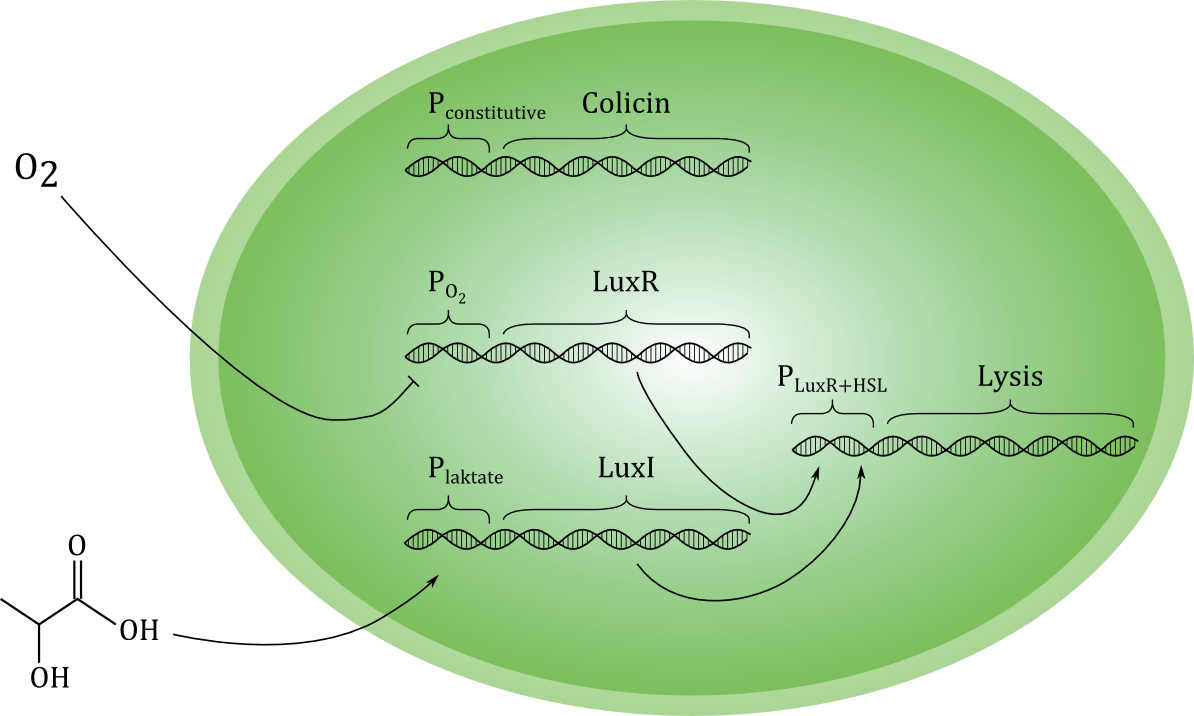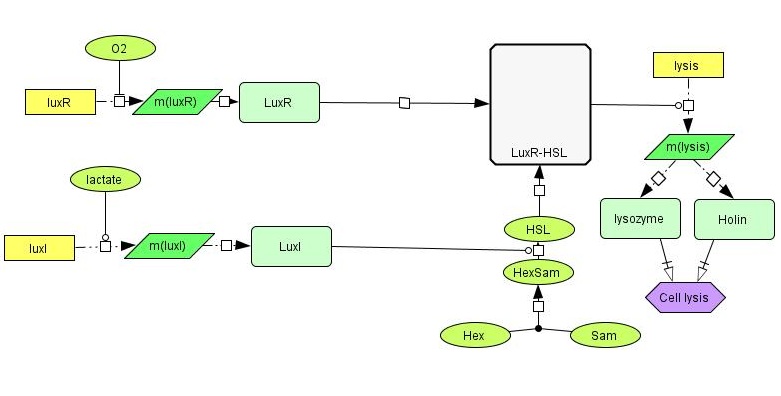Team:NTNU Trondheim/Project
From 2012.igem.org
| Line 47: | Line 47: | ||
First, how can cancer cells be reliably and effectively detected? Early in the process after deciding on the goal, we considered using several human signalling molecules such as HGF and VEGF as cancer indicators, as these are known to be over-produced by tumors. However, we were unable to determine quickly if these would be able to enter and affect ''E. coli'' cells, due to their large size. In contrast, O<sub>2</sub> and lactate are small molecules which are easily taken up by the cells, and are known to directly regulate the expression of various genes. | First, how can cancer cells be reliably and effectively detected? Early in the process after deciding on the goal, we considered using several human signalling molecules such as HGF and VEGF as cancer indicators, as these are known to be over-produced by tumors. However, we were unable to determine quickly if these would be able to enter and affect ''E. coli'' cells, due to their large size. In contrast, O<sub>2</sub> and lactate are small molecules which are easily taken up by the cells, and are known to directly regulate the expression of various genes. | ||
| - | == | + | ==Parts== |
| - | === | + | ===Promoters=== |
To allow our system to work correctly, we need several different promoters. Of these, the most simple is a constitutive (always on) promoter in front of the toxin-producing gene. For this purpose, we have extracted the BioBrick part <partinfo>BBa_J23119</partinfo> from the iGEM DNA distribution kit. Second, a promoter having higher activity at low oxygen levels, similar to those found in tumors. As a candidate for this function, we will test the vgb promoter BioBrick part <partinfo>BBa_K561001</partinfo>. Thirdly, a promoter that is activated by lactate, a possible indicator of tumor cells in the vicinity (or strenous exercise!). We want to clone the lldPp promoter of the ''E. coli'' [http://ecocyc.org/ECOLI/NEW-IMAGE?type=OPERON&object=TU164 lldPRD] operon for this. Lastly, a promoter that is activated by a compound resulting from the activation of the previous two units. In our sketch, this compound is a LuxR-HSL complex, which can activate the promoters of several BioBrick parts, such as <partinfo>BBa_K145150</partinfo> or <partinfo>BBa_R0062</partinfo>. | To allow our system to work correctly, we need several different promoters. Of these, the most simple is a constitutive (always on) promoter in front of the toxin-producing gene. For this purpose, we have extracted the BioBrick part <partinfo>BBa_J23119</partinfo> from the iGEM DNA distribution kit. Second, a promoter having higher activity at low oxygen levels, similar to those found in tumors. As a candidate for this function, we will test the vgb promoter BioBrick part <partinfo>BBa_K561001</partinfo>. Thirdly, a promoter that is activated by lactate, a possible indicator of tumor cells in the vicinity (or strenous exercise!). We want to clone the lldPp promoter of the ''E. coli'' [http://ecocyc.org/ECOLI/NEW-IMAGE?type=OPERON&object=TU164 lldPRD] operon for this. Lastly, a promoter that is activated by a compound resulting from the activation of the previous two units. In our sketch, this compound is a LuxR-HSL complex, which can activate the promoters of several BioBrick parts, such as <partinfo>BBa_K145150</partinfo> or <partinfo>BBa_R0062</partinfo>. | ||
| - | === | + | ===Genes=== |
LuxI is a acyl homoserine lactone syntase, an enzyme catalyzing the production of a homoserine lactone (HSL) from the precursors S-adenosyl methionine (Sam) and hexanoyl-ACP (Hex). The normal function of LuxI is as part of the bacterial lux system, a [http://en.wikipedia.org/wiki/Quorum_sensing quorom-sensing] system allowing cells in proximity to sense each others presence, estimate the local cell population and regulate [https://www.bio.cmu.edu/courses/03441/TermPapers/97TermPapers/lux/bioluminescence.html bioluminescence]. LuxI is available as the BioBrick part <partinfo>BBa_K092400</partinfo>. | LuxI is a acyl homoserine lactone syntase, an enzyme catalyzing the production of a homoserine lactone (HSL) from the precursors S-adenosyl methionine (Sam) and hexanoyl-ACP (Hex). The normal function of LuxI is as part of the bacterial lux system, a [http://en.wikipedia.org/wiki/Quorum_sensing quorom-sensing] system allowing cells in proximity to sense each others presence, estimate the local cell population and regulate [https://www.bio.cmu.edu/courses/03441/TermPapers/97TermPapers/lux/bioluminescence.html bioluminescence]. LuxI is available as the BioBrick part <partinfo>BBa_K092400</partinfo>. | ||
Revision as of 17:08, 25 September 2012
 "
"




